![]()
![]()
![]()
Use LEFT and RIGHT arrow keys to navigate between flashcards;
Use UP and DOWN arrow keys to flip the card;
H to show hint;
A reads text to speech;
49 Cards in this Set
- Front
- Back
|
Looking at the nephron, identify what parts give rise to different kinds of tumors:
|
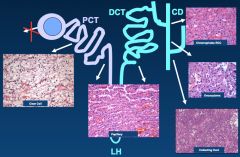
*Most common is CCC; arises from PCT.
*Chromophobe and Oncocytoma come from the intercalated cells of the CD. *No one knows where papillary comes from; shares traits of PCT and DCT. |
|
|
Discuss the Clear cell RCC:
|
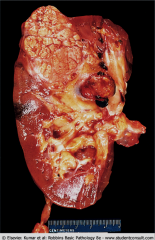
*Most common type of RCC; ~70-80%.
*Arises from proximal tubular epithelium. VHL & Loss of short arm of Chromosome 3 VHL --> up regulates IGF 1 and HIF --> increased VEGF *Gross: -Usually solitary, ranging from 3-15 cm. -Yellow-orange (lipid). -Hemorrhages. -Can have cystic change. -They show invasion into the renal vein. |
|
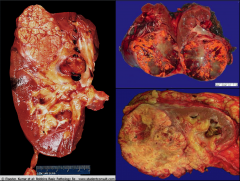
|
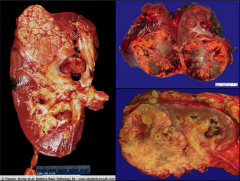
*Gross specimens of CC RCC.
*Left pic shows tumor in the renal vein. VHL & Loss of short arm of Chromosome 3 VHL --> up regulates IGF 1 and HIF --> increased VEGF |
|
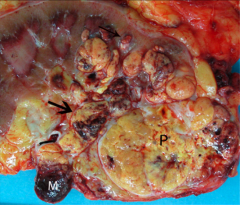
|
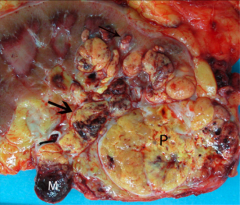
*Renal Vein Invasion in CC RCC. This can progress into the IVC and into the heart!
VHL & Loss of short arm of Chromosome 3 VHL --> up regulates IGF 1 and HIF --> increased VEGF |
|
|
How do we stage RCCs? Why is this important?
|
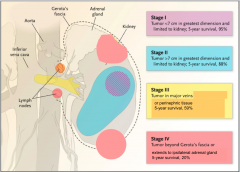
*Renal vein involvement = stage 3.
*Staging correlates with survival. *Tumor size, lymph node involvement, and mets are used to stage. |
|

|

*Clear Cell RCC.
*Note clear cytoplasm and rich vasculature. VHL & Loss of short arm of Chromosome 3 VHL --> up regulates IGF 1 and HIF --> increased VEGF |
|
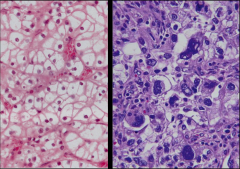
|
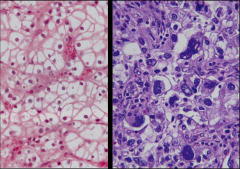
*Clear Cell RCC.
*L: Low grade. Better differentiated. Nuclei aren't so large. *R: High grade. Poorly differentiated. Nuclei are huge. VHL & Loss of short arm of Chromosome 3 VHL --> up regulates IGF 1 and HIF --> increased VEGF |
|
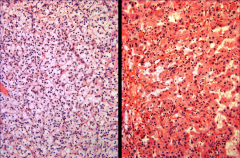
|
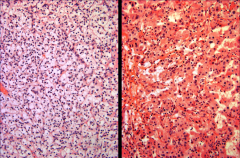
L: Clear cytoplasm in CC RCC.
R: Granular cytoplasm in CC RCC. *Cytoplasm doesn't HAVE to be clear! VHL & Loss of short arm of Chromosome 3 VHL --> up regulates IGF 1 and HIF --> increased VEGF |
|
|
What are the different patterns we see in sporadic vs. inherited kidney cancers?
-Age of onset? -Frequency of each? -Pattern of kidney involvement? -Type of mutation? |
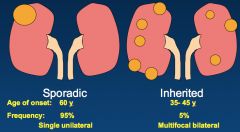
|
|
|
Discuss VHL disease:
-Inheritance? -Where all do we see tumors? |
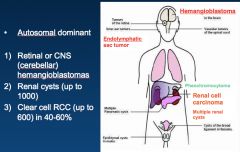
1) Hemangioblastoma
2) Pheochromocytoma 3) RCCs-- ALL CLEAR CELL! *Each patient is different, and may not have all the involvement shown on this slide (VHL gene can have different kinds of mutations). |
|
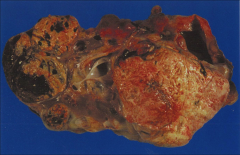
|

*Gross kidney in VHL. Shows multiple cysts and multiple tumors. You can see the yellow color that's characteristic of CC RCC.
VHL --> up regulates IGF 1 and HIF --> increased VEGF |
|

|

*CC RCC in VHL disease.
*Note small size of the tumor on the right; this tumor is likely 1-2mm in diameter. Remember that in VHL disease the patient can have HUNDREDS of these. VHL --> up regulates IGF 1 and HIF --> increased VEGF |
|
|
How is the mutation for CC RCC acquired in VHL (like from the perspective of "hits")?
|
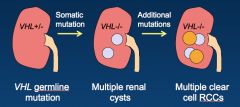
*Short arm of chromosome 3.
*There's a GERMline, universal mutation. *There's a loss of function mutation in the VHL tumor suppressor gene in the kidneys--> bilateral tumors. How is the mutation for CC RCC acquired in sporadic cases (like from the perspective of "hits")? *Kind of similar; still involves short arm of chromosome 3, and 80% of cases still involve the VHL gene. *NO GERMLINE MUTATION. *First event: deletion of 3p. *Second event: somatic mutation or epigenetic silencing; loss of VHL function. *Tumors are SINGLE AND UNILATERAL. |
|
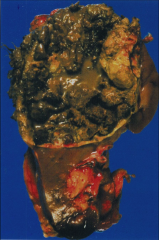
|

*Papillary RCC.
Activation Mutations in MET Oncogene (7q31) (hereditary) or sproadic trisomies *15% of RCCs. *Familial and sporadic forms. *Frequently multifocal and bilateral. *Share phenotype of distal and proximal tubules. *The most common type of RCC in patients who develop dialysis-associated cystic disease. *Good example of a gross specimen: -Well circumscribed -Encapsulated -Hemorrhagic -Cystic *If there's any yellow color present, it's from macrophages. |
|
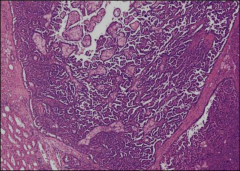
|

*Papillary RCC. On the left you see normal kidney tubules. Tumor is well-cirumscribed and encapsulated.
Activation Mutations in MET Oncogene (7q31) (hereditary) or sproadic trisomies & loss of Y. *Note papillae (with white space between). *Pale cells in the middle are foamy macrophages. |
|
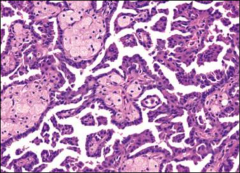
|
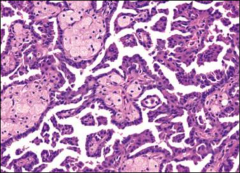
*Papillary RCC, high power.
*Foamy macrophages are the light objects located within the papilla. Activation Mutations in MET Oncogene (7q31) (hereditary) or sproadic trisomies |
|
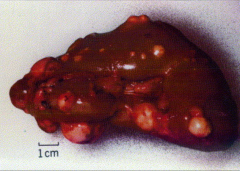
|
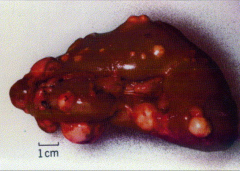
*Hereditary Papillary Renal Cell Carcinoma (HPRCC).
activated MET, trisomy 7 *Bilateral. Multiple tumors. The gold standard for diagnosing prerenal azotemia lies in the prompt return of GFR to normal in these patients following correction of the abnormal hemodynamics. |
|
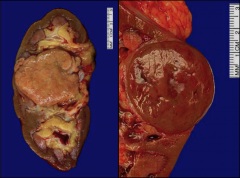
|
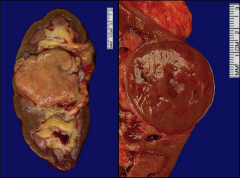
*Chromophobe RCC. Well circumscribed.
Sporadic - Hypodiploid (loss of) DNA: - 1,-2,-6,-10,-13,-17,- 21 Inherited- BHD mutation *5% of RCC *Originate from intercallated cells of collecting ducts. *Excellent prognosis. *Gross: -Well circumscribed. -Tan/ Mahogany. -Rarely, hemorrhage or necrosis. |
|
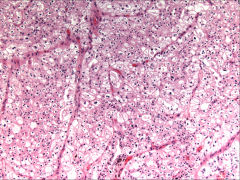
|
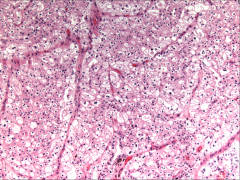
*Chromophobe RCC. Cells are LARGE, and they contain some eosinophilic cytoplasm. They line up along capillaries.
Sporadic - Hypodiploid (loss of) DNA: - 1,-2,-6,-10,-13,-17,- 21 Inherited- BHD mutation |
|
|
Where do we see raisin nuclei? What is the gene mutation in inherited versions of this cancer?
|

Chromophobe RCC
Sporadic - Hypodiploid (loss of) DNA: - 1,-2,-6,-10,-13,-17,- 21 Inherited- BHD mutation *Concentration of large cells around blood vessels. *Prominent cell membranes. *Pale eosinophilic cytoplasm. *Irregular, wrinkled, rasinoid nuclei. *Perinuclear halo. |
|
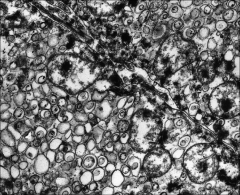
Discuss the characteristics
|

Chromophobe RCC on EM
Sporadic - Hypodiploid (loss of) DNA: - 1,-2,-6,-10,-13,-17,- 21 Inherited- BHD mutation *Cytoplasm is filled with abundant microvesicles (maybe from degradation of mitochondria). *The few mitochondria are localized near to the cell membrane. |
|
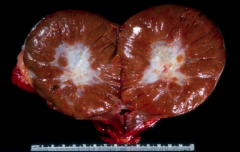
|
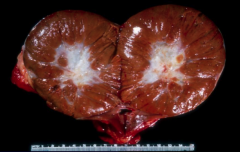
*Oncocytoma.
*Mahogany brown with a central scar. *5% of renal neoplasms. Rare. *Originates from intercalated cells of collecting ducts (just like chromophobe RCC). *BENIGN tumor with excellent prognosis. *Main differential diagnosis with chromophobe RCC. |
|
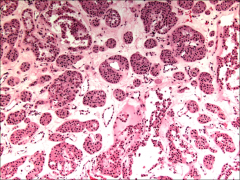
|
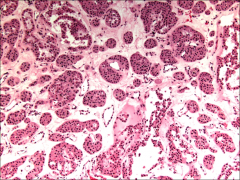
oncocytoma
*Nesting pattern *Round to polygonal cells *Eosinophilic cytoplasm *Small round nuclei *Large nucleoli *Mitotic figures only rarely identified *5% of renal neoplasms. Rare. *Originates from intercalated cells of collecting ducts (just like chromophobe RCC). *BENIGN tumor with excellent prognosis. *Main differential diagnosis with chromophobe RCC. |
|

|

*Oncocytoma.
L: Shows Granular eosinophilic cytoplasm. Granularity is due to huge amounts of mitochondria. R: Mitochondria on EM. |
|
|
Describe the significance of Birt-Hogg-Dube Syndrome :
What organs are involved? |
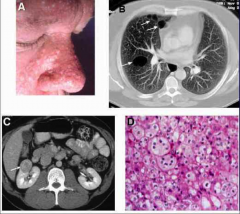
*Caused by Mutations in BHD Gene.
*Benign skin tumors: -Fibrofolliculoma -Trichodiscoma -Acrochordon *Pulmonary cysts. *Renal cell tumors (Chromophobe RCC, oncocytoma, hybrid tumors with features of both.) *BHD gene is on chromosome 17l produces the protein folliculin. |
|

ID these tumors and their gene association:
|
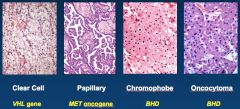
|
|
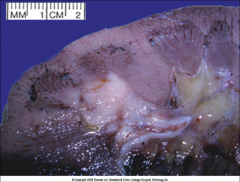
ID and discuss this tumor:
|
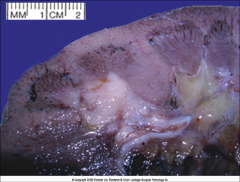
*Collecting Duct (Bellini Duct) RCC.
*RARE, 1% of all RCC. *Arise from collecting duct cells in medulla *Gray-white and firm *Poor prognosis |
|
|
Discuss Renal medullary carcinoma:
Who gets them? What's the gene association? How does the tumor behave? |

Young African American males (mean age 22 y).
*Sickle cell trait (HbAS) in 85% (may be a board question). *Located in medulla. *Originates in collecting ducts. *Highly aggressive; patients die in a couple of months. *May be a subtype of collecting duct carcinoma. |
|
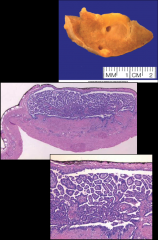
ID and discuss this tumor:
|
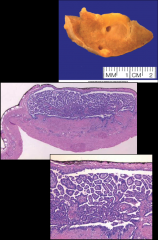
*Renal Papillary Adenoma.
*Benign. *Small (<0.5 cm...if you saw this same tumor and it was >0.5cm, this would by definition be a papillary renal cell carcinoma). *Histologically indistinguishable from papillary RCC. *NOTE: Clear cell, chromophobe, collecting duct-- these are never called adenomas even if they are small. |
|
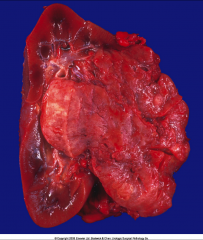
ID and discuss this tumor:
*Who gets these? |
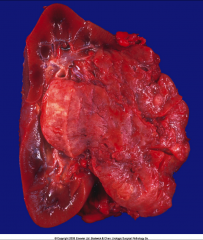
*Angiomyolipoma (composed of vessels, muscle, and fat).
*Benign. *Sporadic or syndromic. *Present in 25-50% of patients with tuberous sclerosis (seizures, mental retardation, autism, and tumors in many organ systems, including the brain, retina, kidney, and skin). Also, rhabdomyoma in the heart. *Susceptible to spontaneous hemorrhage. |
|
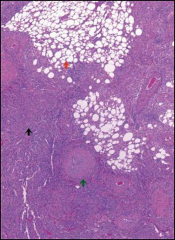
|
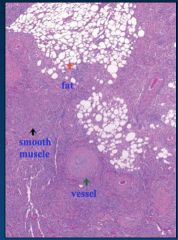
Angiomyolipoma. Think tuberous sclerosis.
|
|
|
What are the Risk Factors for bladder cancer? 5
|
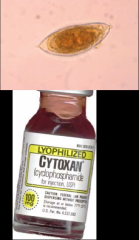
*Cigarette smoking (3-7 fold increased risk).
*Occcupational carcinogens (arylamines). *Schistosoma hematobium (Egypt, Sudan, other African countries) --> SCC. *Drugs (cyclophosphamide and analgesics). *Radiation therapy. presents: *Painless hematuria is the dominant clinical presentation. *Lesions that invade the ureteral or urethral orifices cause urinary tract obstruction. |
|
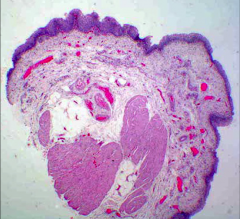
ID and discuss this entity:
|

*This is Papillary Hyperplasia.
*Urothelium is thicker on the left (>7 layers), but no need to count the number of cell layers. *There are undulating folds. *There are no fibrovascular cores. |
|

ID and discuss this lesion:
|

*Urothelial Papilloma.
*<1% of bladder tumors *Younger patients *Usually single lesions *Discrete papillary growth *Central fibrovascular cores *No atypia *Rare recurrences or progression. Benign. |
|

What's the difference?
|
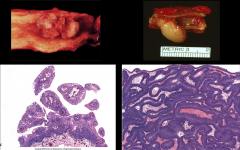
*These are the 2 types of urothelial papilloma.
*Left: Exophytic (growing up within the lumen of the ureter). *Right: Endophytic (inverted papilloma; growing down). *Urothelial Papilloma. *<1% of bladder tumors *Younger patients *Usually single lesions *Discrete papillary growth *Central fibrovascular cores *No atypia *Rare recurrences or progression. Benign. |
|
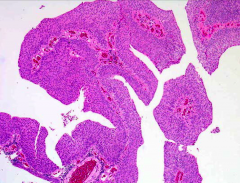
*Discuss this entity:
|

*PUNLMP.
*Somewhere in b/t malignant and benign. *Thickened urothelium (> 7 layers). *Orderly arrangement of cells within papillae. *Minimal architectural abnormalities. *Minimal nuclear atypia. *Mitotic figures rare. *May recur or rarely progress to high- grade tumors. |
|
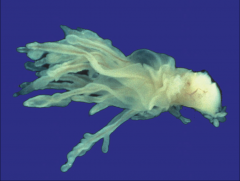
|
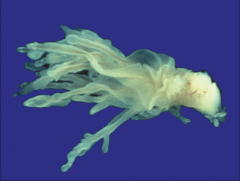
Low-Grade Papillary Urothelial Carcinoma
*PUNLMP. *Somewhere in b/t malignant and benign. *Thickened urothelium (> 7 layers). *Orderly arrangement of cells within papillae. *Minimal architectural abnormalities. *Minimal nuclear atypia. *Mitotic figures rare. *May recur or rarely progress to high- grade tumors. |
|

ID this and describe the features that you are seeing:
|
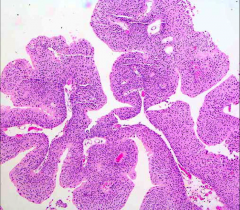
*Low-Grade Papillary Urothelial Carcinoma.
*Thickened layers (>7). *Orderly appearance. *Minimal but definitive cytologic atypia. You see SOME mitoses and some signs of malignancy. *OFTEN recur. *USUALLY non-invasive (90%). |
|

ID this and describe the features that you are seeing:
|
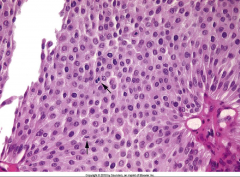
*High power view of Low-Grade Papillary Urothelial Carcinoma.
*Cells maintain polarity. *Scattered hyperchromatic nuclei. *Infrequent mitotic figures. *Mild variation in nuclear size and shape. |
|
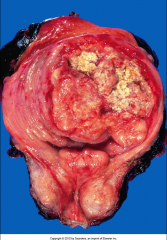
ID and discuss this tumor:
|
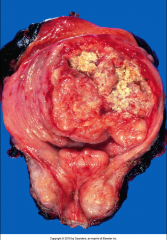
*High-Grade Papillary Urothelial Carcinoma.
-High incidence of invasion into muscularis (detrusor muscle). -Higher risk of progression than low-grade lesions. -Significant metastatic potential. |
|
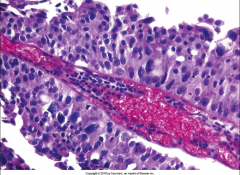
ID this and describe the features that you are seeing:
|
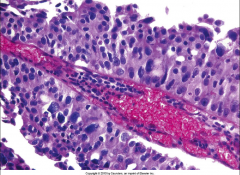
*High-Grade Papillary Urothelial Carcinoma.
*Architectural disarray and loss of polarity. *Nuclear atypia, some huge nuclei. *Frequent mitotic figures. |
|
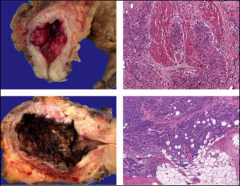
ID and give approximate staging:
|
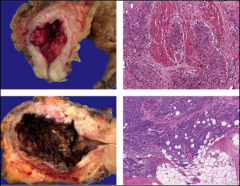
Top: Has invaded muscularis-- T2.
Bottom: Has invaded fat--T3. |
|
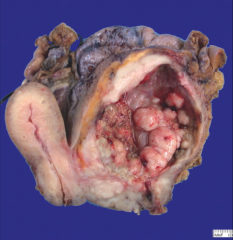
ID this and gives its approximate staging:
|

*Invasive Urothelial Carcinoma. Invading the uterus.
|
|
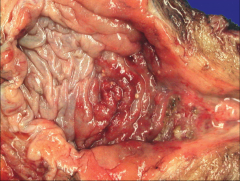
ID and discuss this entity:
|
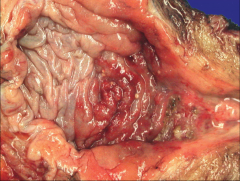
*Urothelial Carcinoma In-Situ.
9p21 deletion. *FLAT; no gross mass. *You see mucosal reddening, granularity, or thickening. *Commonly these tumors are multifocal. *May involve most of the bladder surface. |
|
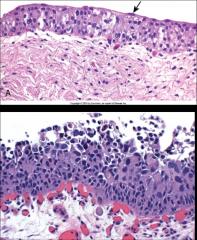
ID and discuss features:
|
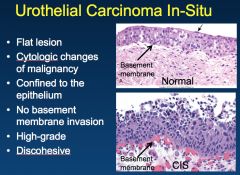
"Deletion on 9 please remember"
|
|

ID and discuss:
|

*Urothelial Carcinoma In-Situ.
"Deletion on 9 please remember" *Left shows denuding CIS. *Right shows shedding of malignant cells into urine. *THESE ARE AGGRESSIVE TUMORS; 50% OF THEM WILL PROGRESS. *Urine samples can be used to track the tumor growth; it's difficult to do this in low grade ones. |
|
|
What's the genetic association of Urothelial Carcinoma In-Situ?
|

*Deletion on chromosome 9!!!!
*Note difference in progression with low grade and high grade tumors. *Note that 15% of low grades INVADE; this is due to an additional mutation of p53 and Rb!! Low grade becomes high grade this way. |
|
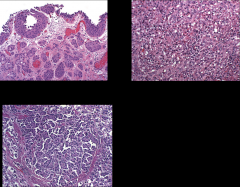
What are these variants of? Discuss.
|
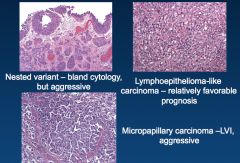
*Variants of urothelial carcinoma: deletion on chromosome 9.
*These aren't terribly important for the test.] |
|
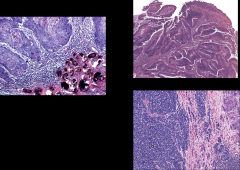
What are these? One of them has a connection to micro/ID.
|
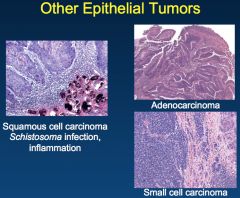
|

